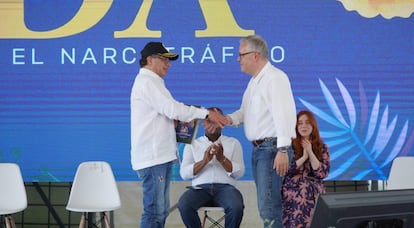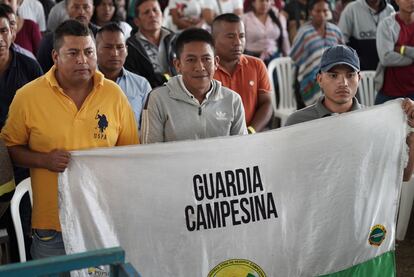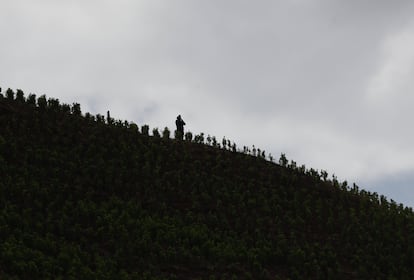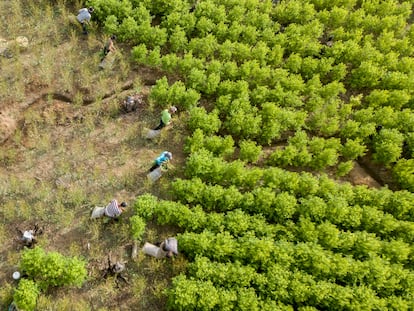Oxygen and asphyxiation: The keys to Gustavo Petro’s new drug policy for Colombia
The most recent figures show that the number of planted coca hectares increased from 204,000 to 230,000 in 2022 and the government is rolling out a ‘concerted effort to swap one economy with another’


The scene could not be more symbolic to highlight the social context of Colombia’s new drug policy: El Tambo, in the department of Cauca, where thousands of smallholders earn a living from growing coca leaf in a region that is the epicenter of the armed conflicts waged by the cartels. More than 3,000 coca growers from Cauca, but also from Norte de Santander and Putumayo — areas where the coca economy is the main way of life for thousands of peasants — arrived in the municipality on Tuesday. President Gustavo Petro was also there, to present his new plan, “By growing life, we banish drug trafficking,” which has been tested over the past year in 27 territories among many of these coca-growing communities, amid a crisis caused by a lack of buyers for reasons on which there is still no consensus.
“At Valle del Micay [in Cauca], We want to make the first concerted effort to swap one economy with another, with the whole community,” said Petro, who again pointed to the “hypocrisy” of the United States in the face of the drug-trafficking problem. This time, however, Petro also spoke of national hypocrisy. “The drug traffickers do not live in the Valle del Micay, they live in Miami, Madrid, or Bogotá. Drug trafficking was not born in Colombian blood,” he added.
Ending an industry that has been in place for decades will not be easy, as Petro has acknowledged. Colombia is the world’s largest producer of coca leaf and cocaine. The most recent figures show that the number of planted hectares increased from 204,000 to 230,000 in 2022. Coca cultivation provides a form of income for thousands of families, and the drug cartels are more active than ever.

Although Petro said that his drug policy represents a “rupture” in the way the problem has traditionally been confronted, he admitted that he will not be able to completely eliminate coca production during his mandate, due to the “extension of the problem we already have.” However, the president added before an auditorium full of coca growers, some of them members of the peasant and indigenous guards set up to protect their territories with non-violent means: “We can prove it in Cauca.”
A few hours’ drive from the meeting, which was attended by almost all of Petro’s ministers, one of Colombia’s most intense wars is being fought. In the Micay area, the Colombian Army is confronting members of a dissident FARC splinter group, the self-styled Central General Staff (EMC), at the same time as the guerrilla organization is sitting at the negotiating table with the government.
Petro’s strategy
Petro’s drug policy can be summarized in two words: oxygen and asphyxiation. The first key focus is aimed at ending the dependence of populations on the drug economy, as well as avoiding the criminalization of coca growers. The asphyxiation is to be used against “strategic and high-value elements of the drug-trafficking system,” including production infrastructure and chemical precursors, illegal finances and money laundering.
The policy is being implemented by Minister of Justice Néstor Osuna, who spoke at the meeting, focusing on the “oxygen” part of the strategy and explaining that each rural area will incorporate a plan that best suits their needs and territory. “One of these is to make them beneficiaries of agrarian reform lands; the other is for those who have coca leaf in protected places [such as natural parks]: the government is willing to pay them a living wage if they change the activity of growing coca leaf for plants native to the jungle. That is, if they become forest rangers instead of coca growers, remaining in their territories and substituting the leaf for some other agricultural product for which they will receive assistance. And the fourth option is to continue growing coca but with licit uses,” Osuna said.

Although coca growers have welcomed the policy and the change of narrative on the war on drugs, they do not agree on all these points. Where there is consensus is on decriminalization, which would benefit, according to Ministry of Justice figures, 32,000 people serving sentences in Colombia’s prisons for drug-related crimes, almost half of whom are women, and often for minor infractions. Vice-minister of criminal policy, Camilo Umaña, has said the government is working so that 3,500 mothers who are heads of families in this situation can serve their sentences with social work and not be deprived of their freedom.
The National Coordinator of Coca, Marijuana, and Poppy Growers (Coccam), which groups together some 200,000 coca growers, also criticized some aspects of the policy. “We do not find the final peace agreement effectively reflected in this document; forced eradication continues to be maintained in our territories and that is not conducive for advancing with crop substitution programs,” Ancizar Barrios, a Coccam leader, told Petro, adding there is concern about the militarization of social life in the communities and that the policy does not include the peasant and indigenous guards equally.
“It is not a whim. We do need the word ‘illicit’ to disappear, at least in relation to the growers, that it be differentiated: we are agrarian coca leaf growers,” added José William Orozco, a representative of indigenous cultivators and a Coccam member.
The promotion of licit coca leaf uses is another area that has achieved broad consensus. “The plants are not responsible for the fact that someone has stuck their nose in them. We have been telling governments for years that we could make products like coca flour and they laughed at us. I tell them: coca flour can feed this country. There is a business there for the peasants,” said César Julián Díaz Morales, leader of the Fundecima community organization.
Petro touched on the same subject. “How can we take the coca leaf and turn it into fertilizer? Because I do not demonize the coca leaf,” said the president, who called on the Secretary General of the United Nations, António Guterres, to remove the coca leaf from the list of prohibited substances. “The coca leaf is not to blame. It is the industrial transformation of some merchants that produces the negative effect.”
Sign up for our weekly newsletter to get more English-language news coverage from EL PAÍS USA Edition
Tu suscripción se está usando en otro dispositivo
¿Quieres añadir otro usuario a tu suscripción?
Si continúas leyendo en este dispositivo, no se podrá leer en el otro.
FlechaTu suscripción se está usando en otro dispositivo y solo puedes acceder a EL PAÍS desde un dispositivo a la vez.
Si quieres compartir tu cuenta, cambia tu suscripción a la modalidad Premium, así podrás añadir otro usuario. Cada uno accederá con su propia cuenta de email, lo que os permitirá personalizar vuestra experiencia en EL PAÍS.
¿Tienes una suscripción de empresa? Accede aquí para contratar más cuentas.
En el caso de no saber quién está usando tu cuenta, te recomendamos cambiar tu contraseña aquí.
Si decides continuar compartiendo tu cuenta, este mensaje se mostrará en tu dispositivo y en el de la otra persona que está usando tu cuenta de forma indefinida, afectando a tu experiencia de lectura. Puedes consultar aquí los términos y condiciones de la suscripción digital.
More information
Archived In
Últimas noticias
There is as much life left to discover on planet Earth as that which is already known
Dozens presumed dead, around 100 injured in fire at Swiss Alps bar during New Year’s celebration
Is porn for women different from conventional porn? We spoke to those who make it
Cartagena de Indias is sinking: What can the city do to mitigate it?
Most viewed
- Sinaloa Cartel war is taking its toll on Los Chapitos
- Reinhard Genzel, Nobel laureate in physics: ‘One-minute videos will never give you the truth’
- Oona Chaplin: ‘I told James Cameron that I was living in a treehouse and starting a permaculture project with a friend’
- David King, chemist: ‘There are scientists studying how to cool the planet; nobody should stop these experiments from happening’
- Why the price of coffee has skyrocketed: from Brazilian plantations to specialty coffee houses










































